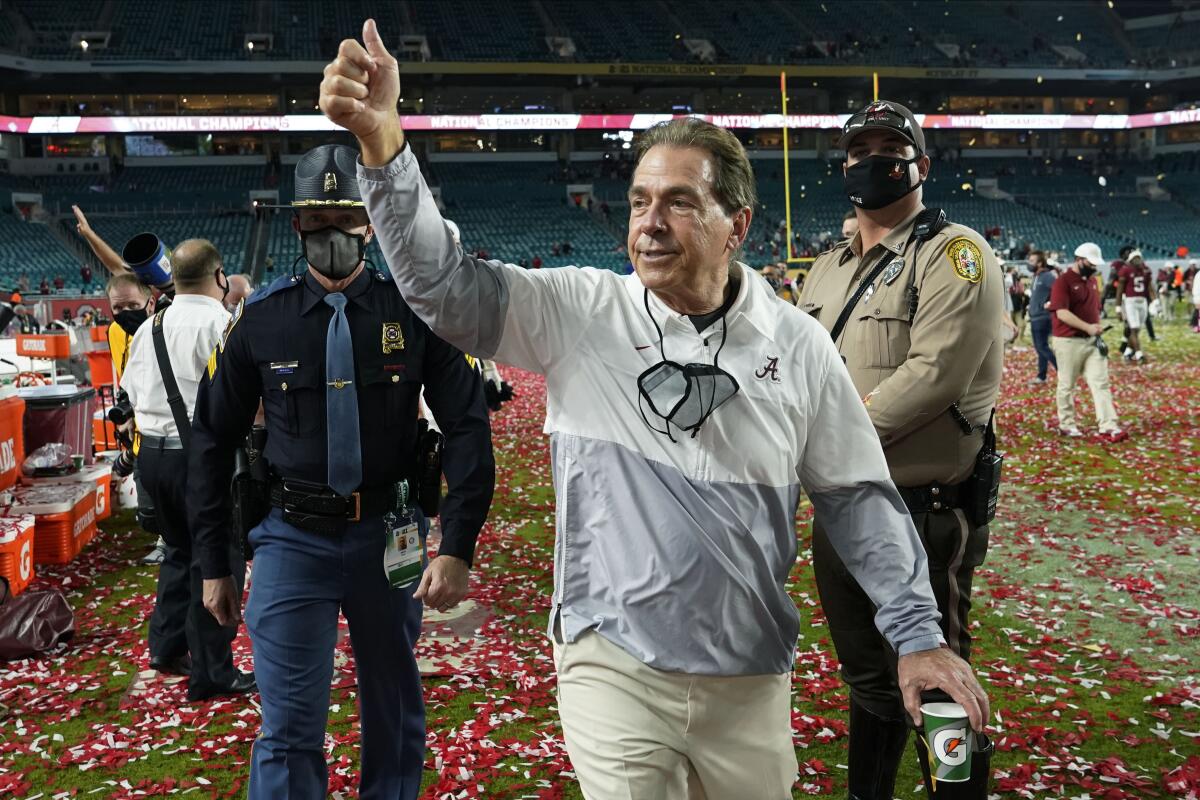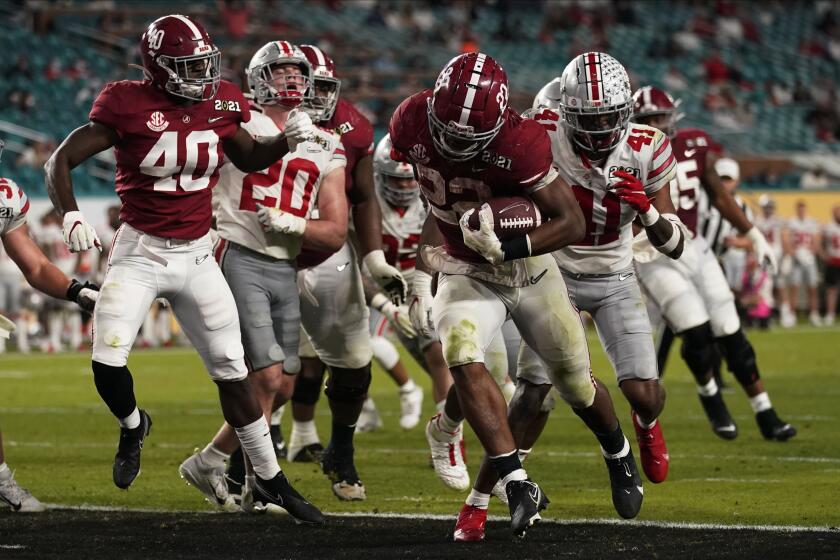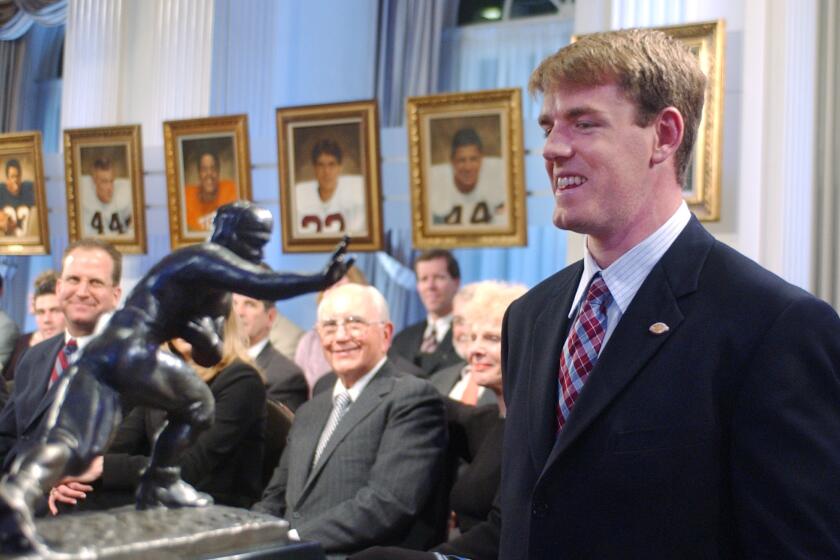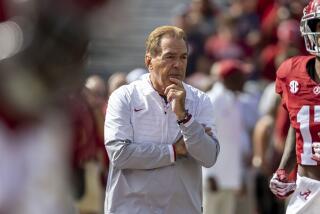Nick Saban wins seventh title — and the rest of college football should be terrified

- Share via
To become the greatest college football coach of all time, Nick Saban had a formula. He learned it coaching under Bill Belichick, practiced it at Michigan State and Louisiana State and perfected it at Alabama, where the legend of “The Bear” quickly made room for “Saint Nick.”
But even as Saban won three national championships in his first five seasons in Tuscaloosa, something began to gnaw at him. Teams that ran high-octane spread offenses won the title in 2013 (Florida State) and 2014 (Ohio State), and Alabama losing to Hugh Freeze’s wildly innovative Mississippi teams in ’14 and 2015 was a personal affront.
By the time Saban lost that second shocker to Freeze, he had already hired Lane Kiffin to begin to retool his offense. The Crimson Tide would win the College Football Playoff that season, but they were led by bulldozing running back Derrick Henry and passed for just 227 yards per game with a Saban-approved quarterback template, game manager Jake Coker, under center.
Kiffin did some subtle work during his time with Saban’s ear, but, for a coach as successful as Saban, change doesn’t come easily. In 2017, with Kiffin gone and dual-threat Jalen Hurts at quarterback, the Crimson Tide ran a spread-option attack but didn’t often test defenses through the air on the way to Saban’s sixth national championship. You may remember, though, that Alabama was on its way to defeat in that CFP title game against Georgia before Saban pulled Hurts in favor of Tua Tagovailoa. Tagovailoa threw the game-winning touchdown in overtime to DeVonta Smith, a name the sports world certainly knows now.
That offseason was when Saban finally let go, when the groundwork for Monday night’s 52-24 aerial assault of the shell-shocked Ohio State Buckeyes in the CFP title game was laid. Three years before Saban won his record seventh national championship, Alabama’s first as a pass-happy program with a pass-content head coach, he took a deep look inward at the Crimson Tide — and at himself — and decided they weren’t as good as they could be.
No. 1 Alabama has won the College Football Playoff national championship game with a 52-24 rout over No. 3 Ohio State.
Keep in mind Alabama had just won the crown. Still, Saban gave Tagovailoa the starting nod the next year over Hurts. Of course, as soon as they really tried a spread passing attack, the Crimson Tide were transcendent. But Saban found himself following some new game scripts, and the last one of the season went haywire in a 44-16 beatdown by Clemson in the 2018 title game.
Last season was supposed to be Tagovailoa’s, but LSU rode its own philosophical shift to the spread and near-flawless quarterback play from Joe Burrow to the championship.
This left Alabama in a precarious spot — for its standard, anyway. For the first time since 2013-14, it went two years without taking the crown. Tagovailoa had been the best quarterback in school history, and yet the Crimson Tide couldn’t get it done? Something wasn’t adding up, but Nick Saban of 2012 would have had an answer ready: Emphasizing the pass had not helped his stalwart defense.
Entering 2020, Clemson would surely be back in title contention with Year 3 of Trevor Lawrence, and Ohio State also would be tough with Justin Fields. Alabama was going to trot out little-known Mac Jones, a delightfully doughy pocket passer with a soft touch, and surround him with future pros and none other than another former USC head coach in Steve Sarkisian directing the symphony.
Saban didn’t listen to the voices that were surely in his head — Turn Jones into a game manager, run the ball, trust your athletes on defense and you’ll win No. 7 — and plunged into football modernity once more.
In starting 12-0, the Crimson Tide put up 349 yards passing per game and 535 total yards and, unthinkably, Smith became the first wide receiver to win the Heisman Trophy since Michigan’s Desmond Howard in 1991, racking up 105 catches for 1,641 yards and 20 touchdowns.
To get to 13-0 and the podium Monday, it was more of the same brilliance from Jones, Smith, running back Najee Harris and Sarkisian.
And Saban didn’t just pass any old coach with his seventh national title — he passed Bear Bryant.
Frankly, the rest of the country should be terrified. Sure, the Alabama dynasty is well-entrenched at this point, but this version was Saban’s best.
In the early 2000s, the spread offense was an equalizer, giving teams that can’t recruit like Alabama and Ohio State a chance to compete by leveraging every inch of the field.
Former USC quarterback and Heisman winner Carson Palmer is among 13 players and coaches who make up the latest College Football Hall of Fame class.
Now, everybody runs the spread or some version of it. Alabama. Clemson. LSU. Ohio State. Heck, even Georgia is doing it. College football has never been so homogenized schematically, which makes breaking through to the sport’s upper crust even harder. How are teams made up of three-star recruits running the spread offense going to do it better than teams made up of blue-chippers running the same concepts?
This isn’t an advocation for teams to start running the wishbone. Football has evolved this way for a reason. But we should accept that this style of offense has reached a tipping point where it is only helping to keep power centered in the same places.
Late in his career when he did not have to budge, Saban made a gut-check call to spread his wings. In doing so, he guaranteed that Alabama will remain the sport’s ruling empire.
More to Read
Go beyond the scoreboard
Get the latest on L.A.'s teams in the daily Sports Report newsletter.
You may occasionally receive promotional content from the Los Angeles Times.













